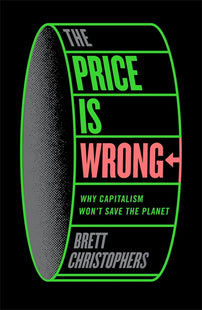The renewable energy paradox
Brett Christophers examines the new paradox at the heart of renewable energy development now that the economic obstacle to decarbonisation has been swept away.

On the one hand, we have been told, the basic economic problem at the heart of the challenge of responding to climate change has effectively been solved. To prevent climate change getting much worse than we already know it will be, the most urgent imperative, it is said, is to eliminate the combustion of fossil fuels. Insofar as the largest share of such combustion occurs in electricity generation, our number-one global priority, it is further said, is to shift such generation from fossil fuel sources – principally coal and natural gas – to zero-carbon sources – principally solar and wind, the ascendant renewables – as rapidly and comprehensively as possible.
For a long time, this was seen as economically improbable, if not impossible, and for a simple reason: fossil-fuel-based electricity was cheaper to generate than renewable power – often much, much cheaper. This basic economic fact stood boulder-like in renewables’ way, evidently indisputable and insuperable. But, from the mid-to late 2000s, things began to move fast. The price of renewable power fell dramatically as investment grew and technologies improved. By the mid-2010s, most estimates indicated that the prices of renewable and dirty electricity were rapidly converging; by the end of that decade, most estimates showed the former now being cheaper than the latter.
It was, we have been told, an historic reversal. The economic obstacle to the decarbonization of electricity had been swept away. ‘Falling cost of renewable energy is leading the race to net zero,’ trumpeted one typical headline in 2020. ‘Renewables increasingly beat even cheapest coal competitors on cost,’ announced a second. ‘Plunging solar prices spell bright future for renewables,’ gushed a third. Anybody paying even the slightest attention to developments in the energy sector in recent years will have noticed this theme becoming a constant drumbeat of economic and policy discourse.
On the other hand, though, we have been told there is nonetheless a problem. One of the main reasons why significant investment in renewables has been occurring for the past decade and more is that governments around the world supported such investment with an array of subsidies and other support mechanisms. These gave the private sector the initial confidence to invest. But, as growing investment through the 2010s precipitated falling technology costs, governments increasingly were minded to reduce fiscal supports in the belief that their job of stimulus was done. Some began phasing down – even removing – subsidies before the decade was out.
Cue panic. No sooner had governments signalled their intention to scale back support for renewables than alarm bells began ringing. Any such scaling back, governments were warned, would be to the severe detriment of the future development and growth of solar and wind power.
The voices of gloom and doom could be heard particularly widely and loudly in the US in 2021 and the first half of 2022. The country’s main form of economic support to renewable electricity developers, its tax credits, were scheduled to expire. Policymakers were told in no uncertain terms that, unless these credits were secured for the long term, the result would be a collapse in investment, and climate catastrophe. Notably, these warnings did not come just from renewable energy companies themselves, whose appeals were neither surprising nor disinterested. Independent commentators also implored US lawmakers to renew meaningful financial support.
The paradox, then, is this. There has been a long-standing consensus that the economic key to renewables winning out is being cheaper than fossil-fuel-based electricity; renewables successfully crossed this apparent Rubicon in the late 2010s, prompting delight that the chief obstacle had been dislodged. And yet, at the same time, the position is also widely held that governments reducing or removing economic support to renewables in the 2020s would have a deeply negative impact on new investment.
Indeed, often the same – seemingly contradictory – beliefs are expressed by the selfsame commentator. In mid-2021, for example, Robinson Meyer, then of the Atlantic and an influential US-based commentator on all things climate, could be heard chiding those who claimed the US was failing to decarbonize. It was not failing, he said; it was broadly succeeding. What is more, ‘most important of all’ to this success had been the fall in renewables costs, which had created a ‘positive feedback loop’. ‘As technologies develop, they get cheaper,’ Meyer enthusiastically explained. ‘As they get cheaper, more companies adopt them.’ And, Meyer reminded readers, the US had done all this ‘without ever passing a [climate] bill’.
Just six months later, however, the same Meyer was mired in self-professed ‘despair’ at the fact that policymakers had not yet renewed the US’s soon-to-expire renewables tax credits. ‘The United States’, he intoned, ‘is on the verge of a massive, history-rewriting failure’ – a ‘very American climate tragedy’. By blocking the bill that would enshrine the credits, Senator Joe Manchin, Meyer said, had ‘virtually sealed the planet’s fate’.
But had not the fall in costs already sealed the planet’s fate – or at least, the United States’ own part in fashioning the planet’s climate future – in the other direction, and all without legislation? Meyer, in short, embodied our paradox.
— An edited excerpt from The Price is Wrong: Why Capitalism Won't Save the Planet by Brett Christophers.
[book-strip index="1" style="buy"]
